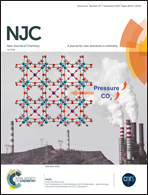Porosity- and content-controlled metal/metal oxide/metal carbide@carbon (M/MO/MC@C) composites derived from MOFs: mechanism study and application for lithium-ion batteries†
Abstract
Implementation of metal–organic frameworks (MOFs) as a precursor and/or template to synthesize metal/metal oxide/metal carbide nanoparticles within a carbon framework (M/MO/MC@C) via thermolysis has attracted considerable interest for electrochemical applications. In particular, the tunability of the weight content and crystallinity of M/MO/MC nanoparticles and porosity control of the morphology-preserved carbon matrix are highly desirable factors for governing the electrochemical performance of M/MO/MC@C composites. Herein, we report a facile synthesis method for adjusting the porosity, content, and crystallinity of M/MO/MC@C composites that are pseudomorphically converted from MOFs (M-HKUST-1, M: Cu and Zn; M-MOF-74, M: Co, Fe, Mg; and ZIF-8). Vapor phase polymerization (VPP), which is a site-specific gas-phase polymerization occurring at open metal sites of MOFs, was first employed to prepare morphology- and crystallinity-preserved polymer@MOF composites, which were then subjected to thermolysis to obtain M/MO@C composites. The polymer content used for VPP was directly related to the M/MO/MC nanoparticle weight content as well as the porosity of the carbon framework. In addition, crucial factors governing the crystallinity of final M/MO/MC nanoparticles were clearly classified in terms of the standard reduction potential of metal nodes and thermodynamic calculation for carbothermic reduction and carbide formation. To identify the advantages of morphology-preserved and content- and porosity-optimized MO@C composites for electrochemical applications, a series of CuO@C samples and CuO obtained from the direct oxidation of MOFs were tested as anode materials for lithium-ion batteries (LIBs). The optimized CuO@C sample exhibited superior electrochemical performance, for instance outstanding long-term stability with a remarkable specific capacity of 410 mA h g−1 after 1000 cycles at a rate of 1000 mA g−1.



 Please wait while we load your content...
Please wait while we load your content...